“The scribal art is the mother of orators, the father of masters,
The scribal art is delightful, it never satiates you,
The scribal art is not (easily) learned, but he
who has learned it need no longer be anxious about it.
Strive to master the scribal art and it will enrigh you.
Be industrious in the scribal art and it will provide you with wealth and abundance,
Do not be careless concerning the scribal art, do not neglect it.”
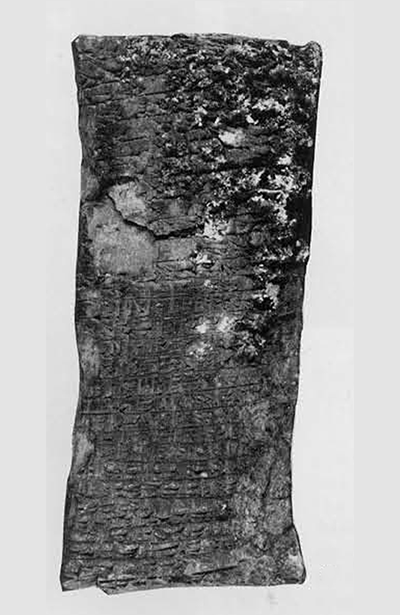
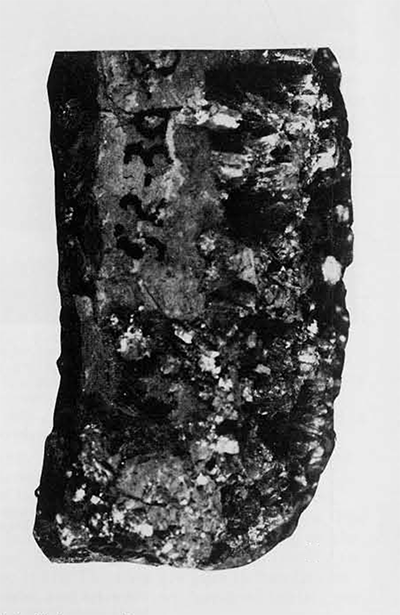
This quotation from an ancient Sumerian hymn in praise of the art of writing was inscribed on a clay tablet around the year 650 B.C. It exemplifies the devotion of the Sumerian scribe to his art and admonishes him not to neglect it. Today, in the Babylonian Section of the University Museum, Assyriologists continue to apply themselves to the study and preservation of the Ancient Mesopotamian scribal traditions. The Museum’s collection consists of approximately 25,000 clay tablets, the majority of which were excavated in the late 19th and early 20th centuries at the Sumerian cities of Nippur and Ur. The range of the collection is truly astounding. It covers a span of over 3000 years—the oldest tablet being an as yet undeciphered text from the Jemdet Nasr period (approximately 2900 B.C.) and the youngest a Seleucid text dating from approximately 200 B.C.
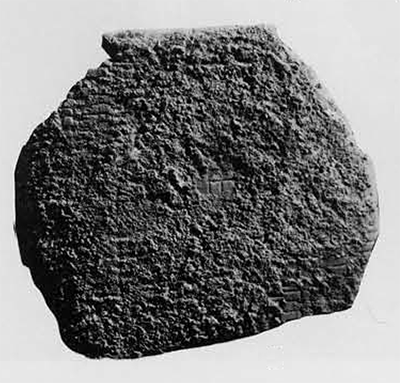
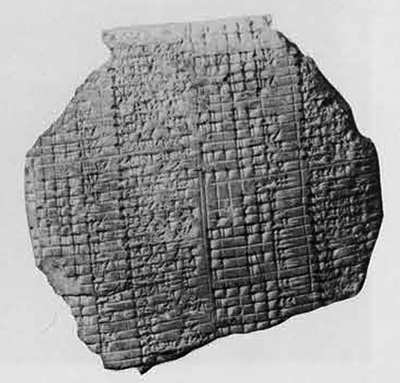
The variety in tablet size is equally surprising. One might find in the same metal drawer a receipt of a business transaction (perhaps the sale of grain) not much larger than a postage stamp next to a tablet whose proportions might be the size of a large book. The size of a tablet can tell one a great deal about its contents. The very large ones are usually literary texts upon which are inscribed ancient and beautiful myths and hymns. A very large text might also be an administrative document from the temple written in the form of a detailed ledger. A tablet about six inches long and three inches wide could contain a letter, or perhaps a business contract for the sale of a house, or even a legal document.
Since the orthography of cuneiform writing changed enormously during the long time span which our collection covers, a trained Assyriologist need only look at the way the cuneiform signs are inscribed on a tablet to be able to tell from which historical period it dates. Thus, perhaps lying next to each other in the same drawer, cats be seen, at a glance, two tablets differing in age by a thousand years or more.
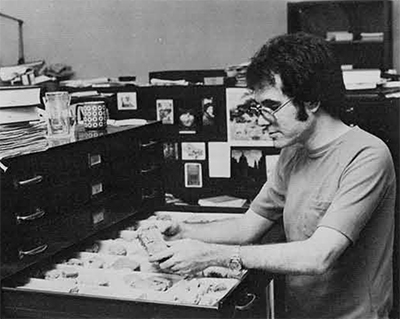
The range of the collection, contentwise, is certainly all encompassing. It includes business and legal documents of all types, even little round clay dockets which record the day’s wages of a harvester. There are letters, often still enclosed in their clay envelopes, from all periods, in both the Sumerian and Akkadian languages. Since the University Museum had the good fortune of excavating the actual scribal school of the temple at Nippur, there are tablets in the collection depicting a child’s first crude attempts to use the stylus and learn his so-called “ABCs” by writing repeatedly the same cuneiform sign on his clumsily formed tablet. More advanced students learned how to write dictionaries and grammars in order to learn Sumerian, since it was no longer the spoken language of the people and had been replaced by the Semitic language, Akkadian. These dictionaries and grammars, the first in man’s recorded history, have proved invaluable in reconstructing and understanding the Sumerian language. They are referred to as lexical texts. Also included in the collection are literary texts of many genres: epics, myths, royal hymns, lamentations, proverbs and wisdom literature. There is even a catalogue of literary texts, listing them by their first lines perhaps for the use of an ancient Mesopotamian librarian.
Also, the University Museum is proud to possess tablets of unusual historical and literary importance, such as fragments from the Epic of Gilgamesh and other myths pertaining to Gilgamesh. There are also some fragments of the famous Laws of Hammurapi, plus an even older law code dating to the reign of King Lipit-Ishtar (1934-1924 B.C.). This is the second oldest written law code in existence.
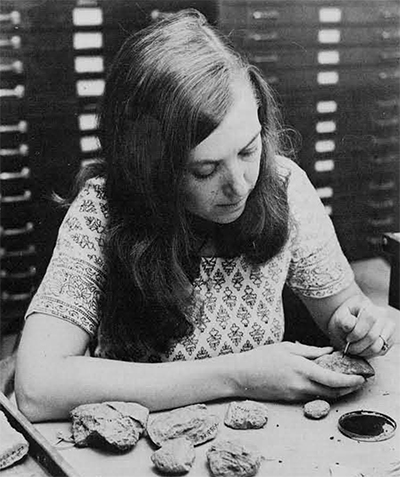
Since their excavation and acquisition, many of the tablets in the collection have begun to deteriorate physically and in the summer of 1974, a project, under the direction of Professor Ake W. Sjoberg , Curator of the Tablet Collection, and Professor Erie V. Leichty, Curator of Akkadian Language and Literature, was undertaken to halt the further disintegration of the collection. Up until this time, only a small number of texts could be treated because the kiln owned by the Museum was quite tiny, and held only a few tablets at a time. However, due to a legacy from the late Pennsylvania state senator, Israel Stieffel, who became interested in cuneiform studies through his acquaintance with Samuel Noah Kramer, and the generosity of the Museum administration, the University Museum was able to build facilities which enable us to conserve not only our own collection, but also the collections of other museums and institutions. We have already completed conservation of the tablets owned by Bryn Mawr College and the Walters Art Gallery in Baltimore, are in the process of treating those from the John Frederick Lewis Collection owned by the Free Library of Philadelphia, and soon expect to begin work on tablets from the Princeton Theological Seminary.
One might ask why these tablets which have survived the course of time need to be so meticulously treated. Although preserved under the Mesopotamian soil for millennia, once unearthed and exposed to the air, a slow but inexorable process of deterioration begins. The problem is twofold. Firstly, the tablets are usually only sun-dried and, while they appear deceptively hard, in reality even the slightest contact with water causes them to dissolve. The high salinity of the clay from which the tablets were made, and the climatic conditions in which they are now kept, create a second problem. Salt crystals Form throughout the tablet and rise to the surface. The evaporation of water from the interior of the tablets transports salts to the surface and deposits them there where they crystallize and eventually cover and obliterate the cuneiform signs. If this is allowed to continue, the entire tablet will crumble. Baking the tablets in a kiln at high temperatures attacks both problems. It renders the tablet virtually indestructible, while breaking down some of the salts. Soaking the tablet then removes the remaining salts not disposed of by baking.
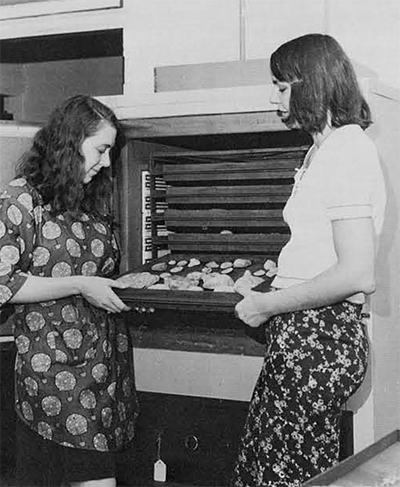
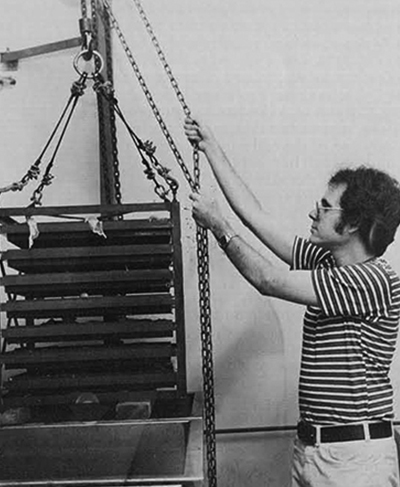
The process by which the tablets are baked and restored is a variation on the systems independently devised by Eric Parkinson at the University Museum and C.A. Bateman of the British Museum. The lablets are removed from the large flat metal drawers in which they are stored. The firs! step in the process insures the preservation of the identification of the tablets. Every tablet, indeed everything in the museum, has a number which was assigned to it at the time it was acquired. This number, an identification tag for the tablet, is essential for cataloguing and all future publications. Formerly these numbers represented a very serious problem experienced by every museum dealing with the conservation of cuneiform tablets. The india ink with which the numbers were written baked off, and an elaborate system of plans and grids had to he devised so that the tablets could be identified and renumbered after baking. Yet, occasionally, numbers were still lost. In a collection the size of the University Museum’s, a lost number can be very serious. Due to the vagaries of the cataloguing system, an unnumbered tablet can take hours to re-identify and, in rare cases, be permanently lost. Other scholars and conservators sought various solutions to the problem such as the use of glaze, but nothing was successful. The problem was solved by Ann Guinan, who discovered that clay slip, used to decorate ceramic pots, could be employed to paint the numbers on the table’s before baking, and a commercially prepared product was found. Upon baking, I he painted number binds to the clay of the tablet. As a preparation for painting the number, a small uninscribed portion of the tablet must be scraped to remove dirt and provide a smooth, clean surface, which facilitates the proper binding of the slip to the clay.
During the numbering phase, many interesting features come to light which bring us close to the original handlers of the tablet. The fingerprints of the scribe who formed the tablet From wet clay are often discernible. Many economic texts contain the hem prints and fingernail impressions of the men involved in the transaction as well as of the witnesses to the proceedings. These were considered to have magical properties which physically reinforced the presence of the people involved. Sometimes, the hem prints can be so vivid as to show the actual weave of the cloth. Designs and drawings of animals also turn up—perhaps the doodling of a bored scribe? Finally, even in this so-called indestructible medium, the “conqueror” worm leaves its traces in the holes and tracks worn in the wet clay.
After numbering, the tablets are placed in rows on special heat resistant trays for baking. The cart is loaded and then rumbles the length of the museum to the tablet laboratory, where the trays are rechecked, straightened, and then placed in the kiln. The kiln holds seven trays, and depending on the size of the tablets, each tray holds twenty to thirty texts. Thus we are able to handle one hundred and filly to two hundred tablets per baking.
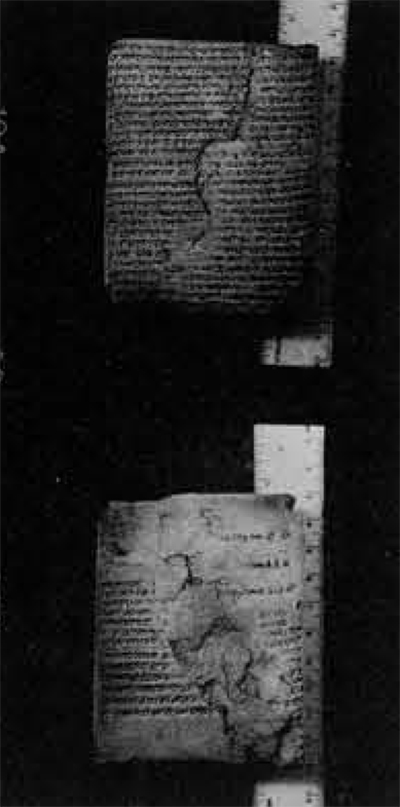
The actual baking process now begins. Although dry to the touch and appearance, the tablets still contain much moisture. If immediately subjected to high temperatures, the too quickly evaporating water would explode the tablets. The ancients themselves were aware of this problem. Holes, obviously man-made, were bored into the clay of larger tablets to keep them from spill ling while being baked. Since this option is not available to us, we raise the temperature slowly from 50°C to 150°C over a period of a few hours. The tablets are then allowed to dry for 48 hours at 150°C with the kiln doors slightly open to allow the evaporated water to escape. On the third day, the hour-by-hour baking process begins. The kiln door is shut, and the temperature is raised by 50°C every hour until 400°C is reached, at which point, the heal is increased in hourly 100°C steps. The final cut-off point is reached at approximately 825°C. This temperature has been arrived at by trial and error. The tablets are actually baked by 700°C, but this temperature is not sufficient to break down the carbonates, one of the more harmful salts in the tablets. A heat of 825°C renders the carbonates harmless, and does not make the tablets overly brittle, a by-product of baking at too high a temperature. The kiln is then shut off and allowed to cool for 48 hours.
It is always an exciting moment when the kiln is opened. A startling difference is immediately apparent not only in the hardness, but also in the color of the newly baked tablets. Instead of the dull gray of the unbaked tablet, there is now the characteristic shrimp pink lint of fired clay. A few of the tablets fire to a light huff color, and some are almost white. This is a result of the varied clays used in Mesopotamia. Unfortunately, flaws inherent in the structure of the tablets often cause them to crack and split during baking. Indeed, we are often greeted with the sight of a tablet which went into the kiln whole and is now in numerous pieces. To make matters worse, many of the tablets were in fragments when excavated, or broken in transit, and subsequently were glued together. During baking, the glue burns off, leaving a pile of broken fragments. In order to a\void losing any of these precious pieces, the fragments are gathered up and carefully wrapped in cheesecloth.
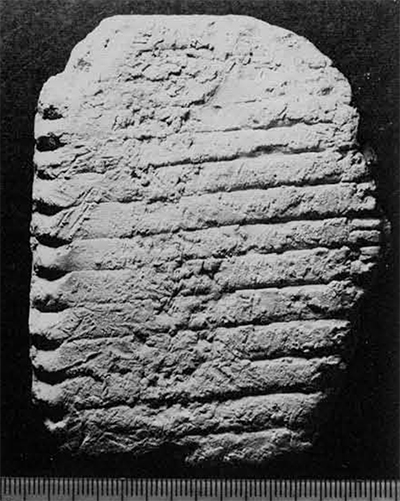
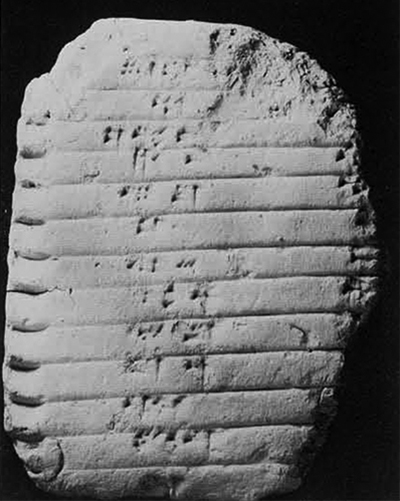
The tablets are now transferred from the baking trays to specially constructed brass soaking trays. Loose salt crystals and black soot are cautiously brushed off the surface. Often removal of the encrusted salt reveals sections of the inscription previously invisible or illegible. To cite an actual case, a visiting Sumerologist was forced to change the translation of several lines in his text after baking revealed the signs more clearly. While cleaning some tablets from the Free Library of Philadelphia Collection, we momentarily were shocked to find that we were brushing away whole sections of what seemed to be parts of the tablet. We soon realized that what we were removing was nothing more than caked dirt. Knowing that whole tablets were more marketable than fragments, wily antiquities dealers had filled out pieces to resemble whole texts. They even went so far as to join fragments from completely dissimilar tablets. We found, for instance, a portion of an Ur III document (dating to approximately 2100 B.C.) attached to a text written in the Neo-Babylonian period (circa 600 B.C.). This hybrid was then passed off as a single tablet to an unwary customer.
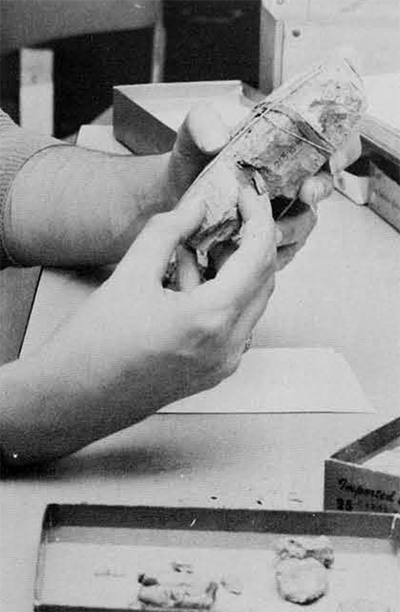
Tablets with very brittle surfaces are not brushed for fear of losing small inscribed bits. However, we find that, even after immersion in water, the soot still clings to the surface and has to be removed after the tablet is repaired. The trays are filled and loaded onto a large brass frame, fitted with seven shelves. This frame is then lowered, by means of a pulley system, into one of three metal tanks to begin the soaking phase of the operation. The tank is then filled until the water level reaches a drain at the top. Since constantly circulating water is necessary to carry away the remaining salts, a small trickle of water is allowed to flow continually into the tank. After two weeks, the tablets are hoisted from the water, and turned over so that both surfaces are equally exposed to the flowing water. The tanks are then refilled with fresh water, and the tablets re-immersed for another two weeks. At the end of this four-week period, the tablets are removed from the tank. They are once more carefully brushed under running water until the surfaces feel clean to the touch, and then allowed to dry. The residue of salt left behind on the soaking trays attests to the value of this procedure.
The trays are reloaded on the cart and returned to the Babylonian Section. Now the most challenging part of our job begins—repairing the broken tablets. The task can be compared to piecing together a three dimensional jigsaw puzzle. A badly shattered tablet may take weeks to reconstruct. The uninscribed interior of the tablet must be rebuilt before the inscribed surface can be reconstructed over it. Actually, most of the tablets, if broken at all, are broken in only a few places and are easily repaired. The adherent used to join the fragments is Polyvinyl-acetate (PVA). Particularly brittle, flaking surfaces are coated with vinyl dissolved in toluene. This prevents further deterioration of the surface and allows impurities to rise to the surface and pass through.
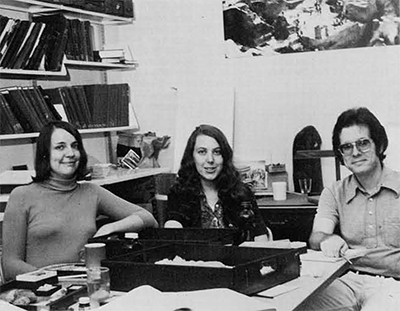
The mended tablets are brushed one final time, and the museum numbers coated with PVA. This is important to protect the number from wear. The tablet is then registered in the Collections Catalogue as having been baked and repaired, and, now impervious to further disintegration, is returned to the drawer. A running tally of the number of baked tablets shows that from September 1974 to September 1975, over 3000 tablets have been treated.
To hold and work with an actual inscribed cuneiform tablet is, in itself, an exciting experience, but to be involved in preserving these ancient documents for posterity is a truly unique opportunity. It enables us to follow the admonitions of the ancient Sumerian hymn quoted at the beginning of the article, “Do not be careless concerning the scribal art, do not neglect it.”
